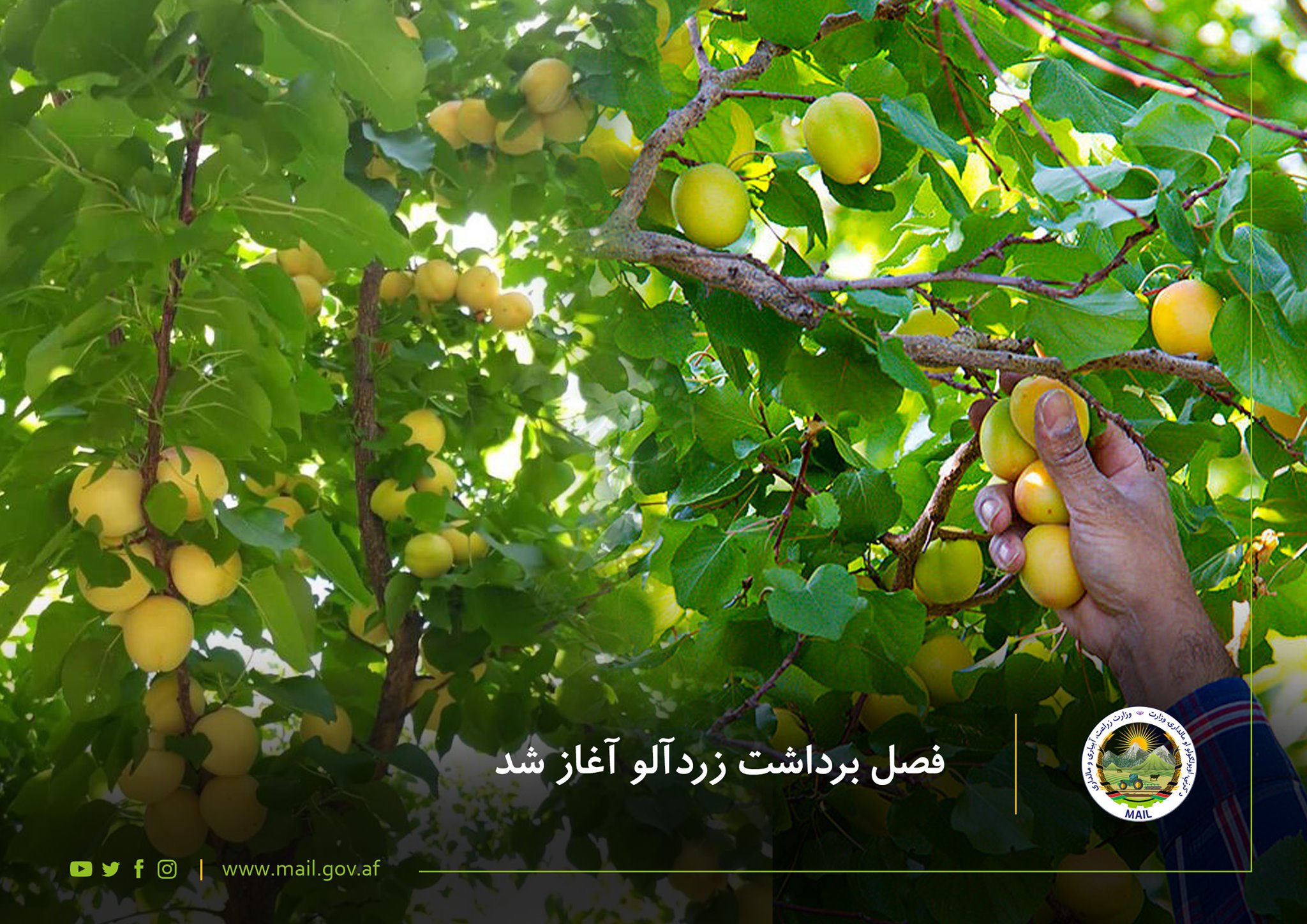The Apricot Harvest Season began

Peasant Weekly / Mohammad Tamim Sediqi
This year, apricot harvest season has started in most provinces of the country, yet the exact statistics of its product collection are not clear yet. However, according to MAIL figures b, last year about 132,000 metric tons of apricots were produced across the country. According to these figures, the area under apricot cultivation reaches 17,481 hectares of the country.
Apricots have good yields and growth in 33 provinces. In classification of the Statistics and Information Directorate of the Ministry of Agriculture, Irrigation and Livestock (MAIL), Ghazni is the largest producer of apricots in the country with a harvest of 13,000 metric tons. Badakhshan with a harvest of 10,000 metric tons, Kandahar with a harvest of 9,824 metric tons, Maidan Wardak with a harvest of 9,760 metric tons and Bamyan with a harvest of 9,640 metric tons were in the second to fifth places, respectively. They have been the main producers of apricots. Good weather, timely rainfall and support of the Ministry of Agriculture for landowners are the main factors why these provinces are leading the way in producing more apricots in the country.
Helmand, Parwan, Uruzgan, Balkh, Herat, Faryab, Baghlan, Zabul, Daikundi and Ghor are among the provinces that are decent for growing and producing apricots.
The apricot tree, scientifically named Prunus armeniaca Rosaceae, is one of the fruit-bearing trees. This tree is one of the deciduous trees that loses its leaves completely during the autumn season. The leaves are pointed, heart-shaped, and light yellowish-green, and the buds are smaller than those of other granules. The terminal leaves are also red, which is a characteristic of identifying this tree. Its flowers are large, single-flowered, with a long, reddish-white stem. This tree has male and female flowers. The fruit is fleshy and yellow, with a pleasant and sweet taste and ripens in mid-summer and for this reason it is also called summer gold.
It should be noted that the fruit of the apricot tree is mostly seen on strong annual branches. The core is oval and brown. It is located inside the nucleus of the brain, some of which taste sweet and some of which are bitter. This kernel contains 40% oil, some protein, sugar and vitamins A and C and cobalt.
There are different types of apricots, which are called Badami apricots, Amiri apricots, Qefi apricots, Durasthi apricots, Nakhchivan apricots, and Shakar-para apricots.
This fruit is is full vitamins A, C and iron. The nutrients in apricots protect the eyes and heart, and the fiber in them is combating the disease.
Apricots are a rich source of beta-carotene (a precursor to vitamin A). Dark orange apricots contain more beta-carotene. Foods containing beta-carotene reduce the risk of heart disease, stroke, cataracts and some cancers.
Therapeutic properties
This fruit purifies the blood, opens the arteries and is a laxative / emollient. In addition, it eliminates bad breath and is astringent. It is useful for anemia due to its cobalt content. It relieves inflammation of the joints and is anti-osteoporosis. It is also useful for weakening the body.
Apricot is good for joint pain and rheumatism due to its salicylic acid content. This fruit is cool and appetizing and quenches thirst and thirst. It is also useful for relieving constipation and hemorrhoids.
Consumption of apricot leaves promotes digestion and prevents constipation or intestinal dryness (constipation). To use the leaf, first wash it with water, then soak it in water and leave it overnight. Then put a lemon in it and in the morning drink the wet leaf with its water. This method is very useful for relieving constipation.
Maintenance
Soil: To plant apricot kernels, you should use soil that has a high drainage capacity and relatively high humidity. In addition, the soil must be able to retain moisture. The best and most suitable soil for planting apricots is loamy, sandy and leafy soil with some rotten soil. When it grows into a large tree, it will require deep soil.
Irrigation: When the seedlings are inside the pot, you should irrigate them when the soil surface is completely dry. Since the roots of the apricot tree are very sensitive to waterlogging, excessive irrigation will cause the roots of the seedlings to rot.
Light: In order for an apricot tree to grow well, it must receive enough sunlight. Apricots should receive 8 hours of direct sunlight daily. If you keep seedlings indoors, place them in the brightest part of the house. Insufficient light changes the appearance of the tree.
Temperature: The apricot tree is able to withstand a wide range of temperature changes, including hot summers and cold winters. It can be good for the apricot tree and not cause problems. However, extreme temperature changes can damage the tree. The apricot tree is more tolerant of high temperature soils.
Pests: The main pests of apricot tree are spider mites, aphids, bedbugs, woodpeckers and fruit-eating bees that you must repel using appropriate poisons.